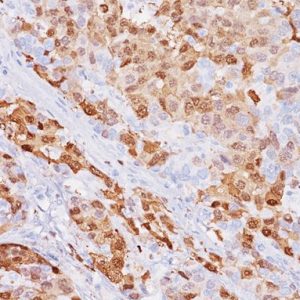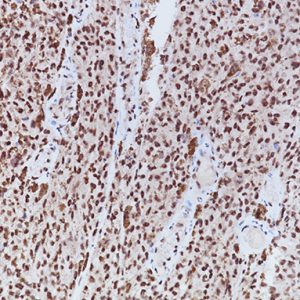Description
p53 has been observed to act as both as a tumor-suppressor and transcription factor. p53 activation by DNA damage or other stress signals is reported to trigger DNA repair, cell-cycle arrest or apoptosis. The nuclear p53 gene is located on chromosome 17p, a frequent site of allele loss in many tumors (60%) including breast, colon and lung. Studies have shown this high affinity p53 rabbit monoclonal is very specific and is superior to other p53 mouse monoclonal antibodies. p53 antibody recognizes both wild-type and mutant p53.
SPECIFICATIONS
Specifications
| WEIGHT | N/A |
|---|---|
| DIMENSIONS | N/A |
| INTENDED USE | IVD |
| SOURCE | Rabbit Monoclonal |
| CLONE | EP9 |
| ISOTYPE | IgG |
| ANTIGEN | p53 |
| LOCALIZATION | Nuclear |
| POSITIVE CONTROL | Breast and colon carcinomas |
DATASHEETS & SDS
| Download Data Sheet |
| Download RUO Data Sheet for International |
| Download intelliPATH™ Data Sheet |
| Download SDS Sheet |
Regulatory Notice: Biocare’s IVD-labeled products comply with US-FDA and European IVDD regulation. Other regions may have additional requirements for such labeling, please contact your local distributor.
REFERENCES
1. Harris C.C. p53: at the crossroads of molecular carcinogenesis and risk assessment. Science 262: 1980-1981 (1993).
2. Alexiev BA, Bassarova AV, Popovska SL, Popov AA, Christov CZ. Expression of c-erbB-2 oncogene and p53 tumor suppressor gene in benign and malignant breast tissue: correlation with proliferative activity and prognostic index. Gen Diagn Pathol, Jun142(5-6):271-279, 1997.
3. Center for Disease Control Manual. Guide: Safety Management, NO. CDC-22, Atlanta, GA. April 30, 1976 “Decontamination of Laboratory Sink Drains to Remove Azide Salts.”
4. National Committee for Clinical Laboratory Standards (NCCLS). Protection of laboratory workers from infectious diseases transmitted by blood and tissue; proposed guideline. Villanova, PA 1991;7(9). Order code M29-P.
REVIEWS (0)
Be the first to review “p53”
You must be logged in to post a review.







Reviews
There are no reviews yet.